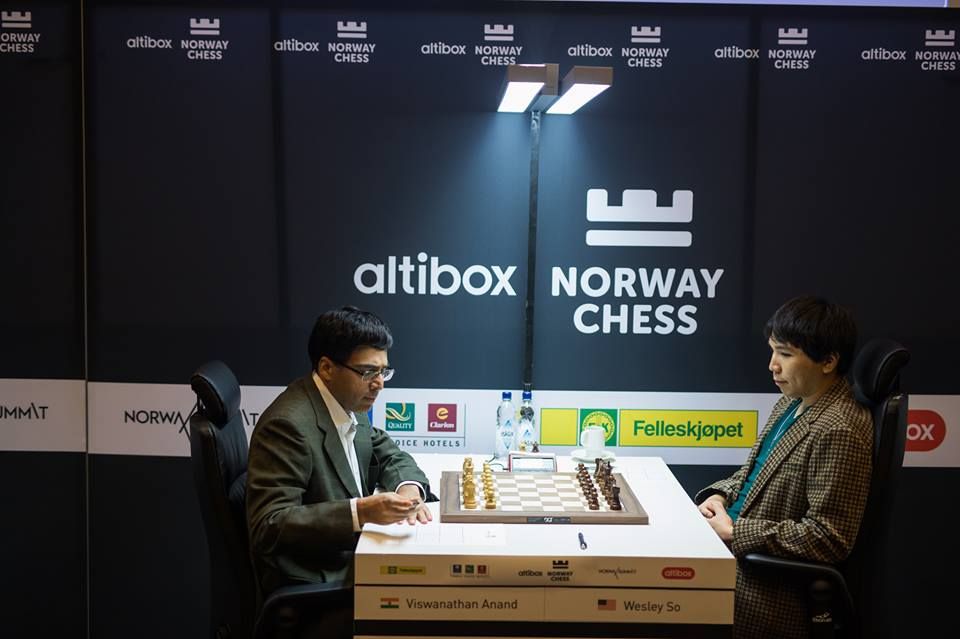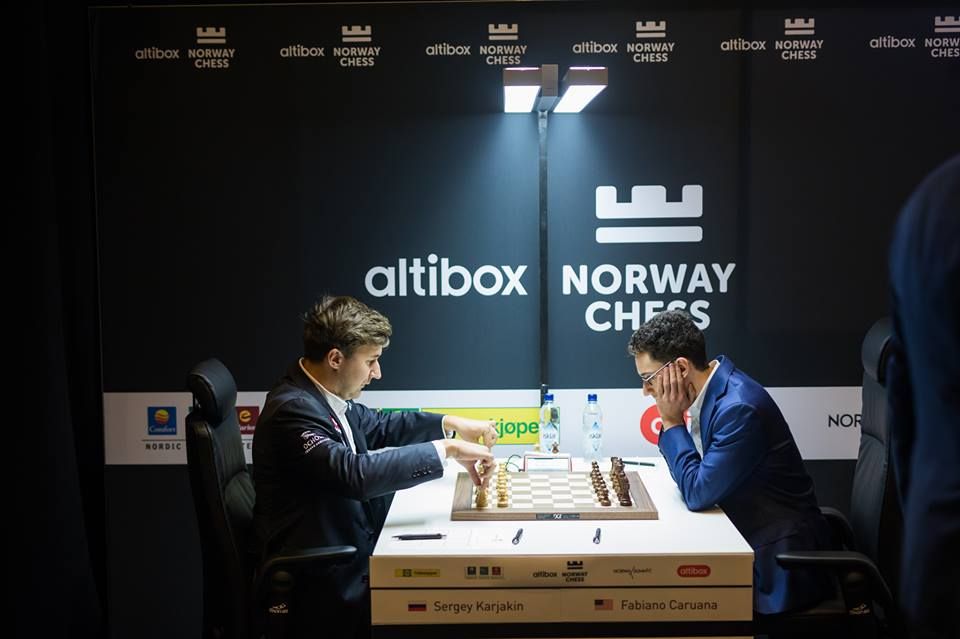Norway R05: Five draws; Anand splits point against So
After some sensational games in round 4, players at the Altibox Norway Chess 2017 seemed to have wanted to take things slower. All five games of the fifth round were drawn. While Kramnik and Karjakin fought hard to force a win against Nakamura and Caruana respectively, Levon Aronian unleashed the razor sharp Marshall Gambit against Maxime Vachier-Lagrave. On the other hand, both Vishy Anand and Magnus Carlsen chose to start-off with the Italian opening against Wesley So and Anish Giri. We have analysis, pictures, videos and much more.
Photos by Lennart Ootes


The game between Anand and So looked dull at the outset but had its fair share of exciting tactics lurking in the background. Struggling with his form in this tournament, Anand seemed to have taken a safety first approach for this game. After his second loss in the previous round, he evidently didn’t want to lash out and do something uncanny against someone like Wesley, who has been performing consistently well throughout the year.
However, this didn’t mean that the five-time World Champion wasn’t going to pose any problems to his opponent. He came up with a crafty little pawn sacrifice to try and unsettle the American. However, this didn’t quite help as Wesley said after the game that he had seen Anand’s idea before. Immediately after grabbing the sacrificed pawn, Wesley was able to exchange queens and the position started to look drawish. As Anand demonstrated after the game, he still had some means to tug for an edge. But the American too was up for the task. The position soon liquidated into a dead drawn bishop endgame and the players shook hands in 33 moves.
[Site "Stavanger NOR"]
[Date "2017.06.11"]
[Round "5.2"]
[White "Anand, Viswanathan"]
[Black "So, Wesley"]
[Result "1/2-1/2"]
[ECO "C50"]
[WhiteElo "2786"]
[BlackElo "2812"]
[Annotator "Sagar Shah"]
[PlyCount "65"]
[EventDate "2017.06.06"]
Nxd5 9. Re1 (9. Nbd2 {is the main move in the position.}) 9... Bg4 (9... Nb6
10. Bb3 Bd6 11. Bg5 $16) 10. h3 Bh5 11. Nbd2 (11. g4 Bg6 12. Nxe5 Nxe5 13. Rxe5
c6 $44) 11... Nb6 12. Ba2 $5 {Anand sacrifices a pawn in order to go into an
endgame where he would have some compensation.} (12. Ne4 {is an interesting
move, but after} Nxc4 13. Nxc5 Nd6 14. g4 Bg6 {Black seems to be doing
completely fine.}) 12... Qxd3 13. a5 Bxf3 $1 (13... Nd7 14. Ne4 Qxd1 15. Rxd1
Bxf3 16. gxf3 Bd6 17. Nxd6 cxd6 18. Rxd6 $16) 14. Nxf3 Qxd1 15. Rxd1 {White
has the bishop pair and control of the d-file as the compensation for the pawn.
} Nc8 16. b4 Ba7 17. Re1 Nd6 {Wesley is a pragmatic player. He gives back the
pawn in order to get his piece co-ordinated.} 18. Nxe5 Nxe5 19. Rxe5 Rfe8 20.
Rxe8+ Rxe8 21. Kf1 Ne4 22. Bd5 c6 (22... Nxf2 23. Bxb7 $16) 23. Bxe4 Rxe4 24.
Bd2 Kf8 25. Re1 Rxe1+ 26. Bxe1 {The position is just drawn.} Ke7 27. Ke2 c5 28.
Kd3 cxb4 29. cxb4 Kd6 30. Kc4 b5+ 31. axb6 Bxb6 32. b5 axb5+ 33. Kxb5 1/2-1/2

The day’s most thrilling encounter was Vladimir Kramnik against Hikaru Nakamura. Kramnik, playing with the white pieces, employed a zany line to counter Nakamura’s Sicilian and continued playing enterprisingly by offering a piece sacrifice in queen-less middle game to keep pressure on Naka’s position. The American rightly declined the offered knight and defended in a very resourceful manner to liquidate into a rook and knight versus rook and bishop endgame a pawn down. Also, he was hell bent on creating complications. Exchanging his king-knight’s pawn for Kramnik’s king-bishop pawn, he created a passed pawn for himself on the king’s file. After 49 moves, the players signed peace by repeating moves.
Analysis by GM Tiger Hillarp Persson:
[Site "Stavanger"]
[Date "2017.06.11"]
[Round "5"]
[White "Kramnik, Vladimir"]
[Black "Nakamura, Hikaru"]
[Result "1/2-1/2"]
[ECO "B53"]
[WhiteElo "2808"]
[BlackElo "2785"]
[Annotator "Tiger Hillarp-Persson"]
[PlyCount "98"]
[EventDate "2017.??.??"]
knight on f6 before playing d4. In this way White avoids some of Black's most
popular antidotes.} (3. d4 cxd4 4. Qxd4 {and Black has three main options:} a6
(4... Nc6 5. Bb5 Bd7 {(Compare this position to the one that arises after 5...
Nc6 later.)} 6. Qd3 {is one of those awkward lines that are aimed at getting a
Maroczy setup, even at the price of playing some strange moves.} (6. Bxc6 Bxc6
7. Nc3 {, is similar to the game, but here Black can also play} h6 {,
intending e7-e5 and Nf6.}) 6... g6 7. O-O Bg7 8. c4 Nf6 9. Nc3 O-O 10. h3 a6
11. Bxc6 Bxc6 12. Nd4 {could be called a tabiya.}) (4... Nf6 {has become more
popular lately and White usually continues} 5. Bb5+ Bd7 6. c4 $5 (6. Bxd7+ Qxd7
7. c4 Nc6 8. Qd3 Qg4 9. Nc3 (9. O-O Qxe4 10. Qb3 Rb8 $2 (10... Ne5 $1 {and
White has little to show for having squandered the center.}) 11. Nc3 $36 {
Bozinovic,B (1969)-Vucinic,G (2294) Veliko Gradiste 2016}) 9... Qxg2 10. Rf1
Rc8 {was good for Black, in Carlsen,M (2855)-Vachier Lagrave,M (2789) Leuven
2016.}) 6... g6 7. Nc3 Bg7 8. O-O O-O 9. Qd3 {with another typical Maroczy/
Bb5+-Sicilian.}) 5. c4 Nc6 6. Qe3 $5 {The
let's-put-the-queen-on-a-strange-square has gone so far that "strange" has
aquired a different meaning. If it works it is good and works it does.} g6 7.
h3 Bh6 8. Qc3 Qa5 9. Qxa5 Nxa5 10. Bxh6 Nxh6 11. Nc3 Be6 12. b3 (12. Nd5 $1)
12... O-O 13. Nd4 Nc6 14. Nxe6 $2 fxe6 $15 {0-1 (49) Muzychuk,M (2528)-Edouard,
R (2636) Cap d'Agde 2015}) 3... Nf6 ({After} 3... a6 $5 {White's only decent
way to avoid the Najdorf is} 4. g3 $5 {when Black can choose between a dragon
set-up and a more traditional Taimanov- or Najdorf-fianchetto.}) 4. d4 cxd4 5.
Qxd4 a6 ({White is hoping for} 5... Nc6 6. Bb5 Bd7 7. Bxc6 Bxc6 8. Bg5 e6 9.
O-O-O {which is a whole different ball game. Last I checked theory seemed to
agree that Black is all right here, but with the rise of the machines it is
quite possible that this verdict has changed.} Be7 10. Qd3 Qa5 11. h4 {leads
to a sharp game, but whether it is balanced I don't know.}) 6. e5 $1 {
Otherwise Black gets a perfect Sicilian with Nc6 on the next move.} Nc6 7. Qa4
dxe5 8. Nxe5 Bd7 9. Nxd7 Qxd7 {White has gained the bishop pair, but Black has
a harmonious position and develops fast. Intuitively I would not evaluate this
position as "better for White", as my silicon friend does, but the more I look
at it the more I feel that I perhaps should.} 10. Bd2 {A logical move that
paves the way for 0-0-0, but there is also something to be said for the
alternative, more positional way:} (10. Be3 {White is aiming to play g3, Bg2,
Rd1 and then take it from there. Black cannot sit idly by and wait, but needs
to find a way to put a stick into White's wheel.} e6 (10... g6 $6 11. Rd1 Qc7
12. g3 Bg7 13. Bg2 O-O 14. O-O Rac8 15. Bf4 Qb6 16. Qb3 Qxb3 17. axb3 $14) 11.
Rd1 Qc7 12. g3 Bb4 (12... Be7 $6 13. Bg2 Rc8 14. O-O O-O 15. Bf4 Qb6 16. Qb3 {
and again White gets a comfortable engame advantage.}) 13. Bg2 O-O 14. Qb3 Ng4
15. Bf4 e5 16. Be3 Bxc3+ 17. Qxc3 Nxe3 18. fxe3 Rad8 {and Black is closing in
on equality. Still, this line clearly shows that Black is under some pressure.}
) (10. Bg5 {is less logical since it is Black's queenside that ought to be
attacked. After} e6 11. g3 Bb4 {White cannot play} 12. Bg2 $4 {due to} b5 13.
Qb3 Nd4 $1) 10... g6 {With white's king evacuating towards the queenside, it
is a good idea to aim the bishop towards b2.} 11. O-O-O Bg7 12. Bg5 {This is a
new move.} (12. Be3 Qc8 13. h3 $6 (13. g3 $5 {is more to the point, but I feel
Black should be fine here.}) 13... O-O 14. g4 {This arrangement is too slow
for White as it does not threaten the king while Black is not afraid to have
the knight kicked away from f6.} b5 15. Qb3 $6 Na5 (15... e6 $1) 16. Qb4 {
was unclear, in Blehm,P (2420)-Janssen,R (2345) Calicut 1998.}) 12... Qg4 (
12... Qf5 {is more ambitious. Perhaps Nakamura wanted to avoid Kramnik's
preparation, thinking "he probably thought I would keep the queens on, so I'll
swap them!". Maybe not.} 13. h4 (13. Bxf6 $2 Qxf6 {is absolutely horrendous
for White}) 13... O-O 14. f3 b5 15. Qf4 Qxf4+ 16. Bxf4 Rad8 {and with Black's
pieces are working very well together.}) 13. Bxf6 {From a general
which-piece-ought-to-be-swapped point of view, this move is a bit surprising,
but it soon becomes obvious that it is a good move.} Qxa4 14. Nxa4 ({Not} 14.
Bxg7 $2 Qf4+ 15. Kb1 Rg8 $19) 14... Bxf6 15. c3 $1 {This move restricts both
the knight and the bishop. Black has no equivalent move to neutralize White's
minor pieces and thus Black's queenside comes under pressure.} e6 {At some
point Black must take control of d5 and this is as good a time as any.} ({
The active} 15... b5 {doesn't solve Black's problems:} 16. Nc5 (16. Nb6 Ra7 17.
g3 e6 18. Bg2 Nb8 $5 19. Rd3 O-O 20. Rhd1 $36) 16... O-O {and although there
are other ways to get some advantage, the principled} 17. Nd7 {seems the
simplest. After} Rfe8 18. Nxf6+ exf6 19. g3 Ne5 20. h3 Rac8 21. Kb1 {Black's
knight is not quite at par with the bishop.}) (15... Rc8 16. g3 Rc7 17. Nb6 e6)
16. g3 Rc8 17. Bg2 Be7 18. Rd2 h5 $1 {Since there is no way to exchange ones
way out of the pressure, priority number one becomes to get some counterplay.}
(18... O-O 19. Nb6 Rc7 20. Rhd1 Rd8 21. Rxd8+ Nxd8 22. Kc2 {and White has
terrific pressure on the queenside.}) 19. Rhd1 (19. h4 $2 {would reduce
White's winning chances significantly as the kingside pawns are set to be
chewed on by Black's bishop.}) 19... h4 20. Nb6 (20. g4 $2 Bg5) 20... Rc7 21.
Na8 {This kind of repetition saves time and also sends a message to the
opponent about who is in the drivers seat.} Rc8 22. Nb6 Rc7 (22... Rd8 23. b4
hxg3 24. hxg3 Rxd2 25. Rxd2 Rh2 26. Bxc6+ bxc6 27. a4 {, followed by Nc4, is
difficult for Black as both a6, c6 and - at some point - f7 are weak.}) 23. f4
$1 hxg3 24. hxg3 Rh5 (24... g5 $6 25. f5 $1 exf5 26. Nd5 Rc8 27. Rf2 {is just
awful for Black. Observe that} Rh2 $2 {fails due to} 28. Nb6 $1 {followed by
Bxc6+ and Rxh2.}) 25. Na8 $1 Rc8 26. Rd7 $1 {A wonderful concept built on the
strength of the unopposed bishop.} Rh2 (26... Rxa8 27. Rxb7 Rc8 (27... Nd8 28.
Rxe7+ Kxe7 29. Bxa8 $16) 28. Bxc6+ Rxc6 29. Rb8+ {and Black has to give the
bishop.}) 27. Be4 $1 Re2 28. Bxc6 $2 {This move ruins it for Kramnik.} ({
The best move is} 28. Bf3 $1 {The point is that if Black plays} Re3 {, then} (
28... Rh2 29. Nb6 Rd8 30. Rxb7 $16) 29. Bxc6 bxc6 30. Nc7+ Kf8 31. Rh1 Bf6 32.
Rh7 Bg7 {looks almost exactly like the game, with the exception of the
placement of Black's active rook. In the game it is on e2, but here it is on
e3. But how can this be better for White? Now the rook is not just active but
also threatening a pawn! However, what is most important is that the rook is
not just on a casual stroll, windowshopping for g-pawns, but on an important
mission to protect the e6-pawn. If the rook moves away White will strike with
Nxe6! So, White can continue with} 33. Kd2 $1 {and the rook ends up in a
pickle:} Re4 (33... Rxg3 $1 {might be the best still although} 34. Nxe6+ fxe6
35. Rdxg7 Rg2+ 36. Kc1 $1 (36. Ke3 Rxb2 37. Ra7 Kg8 {is less clear.}) 36...
Rg1+ 37. Kc2 Rg2+ 38. Kb3 Rb8+ 39. Rb7 Rxb7+ 40. Rxb7 Rg4 41. Ra7 Rxf4 42. Rxa6
g5 43. Rxc6 Kf7 44. a4 g4 45. Rd6 {and White should win.}) 34. b3 c5 35. Rh1 c4
36. b4 e5 37. f5 $1 gxf5 38. Rh5 Rg4 39. Rxf5 Rxg3 40. Ke2 $1 f6 41. Kf2 Rg4 (
41... Rxc3 $2 42. Ne6+) 42. a4 {with complete domination.}) 28... bxc6 29. Nc7+
Kf8 30. Rh1 Bf6 31. Nxa6 Ra8 $1 {Black's activity is no less valuable than
White's extra pawn.} 32. Nb4 (32. Rh7 $2 Rxa6 33. Rhxf7+ (33. Rdxf7+ Kg8) 33...
Ke8) 32... c5 33. Nd3 Rxa2 34. Kb1 Ra8 $1 35. Nxc5 Rb8 36. Rb7 Rxb7 37. Nxb7
Rg2 38. Rh3 g5 $1 {Improving the scope of the bishop and opening up a road
towards g4 for the king.} 39. fxg5 Bxg5 40. Nc5 Be7 $1 {If White's knight goes
to d3, the bishop will control if from d6. If the knight goes to e4, then the
bishop is already in the right spot and Black can play f7-f5.} 41. Nd3 Bd6 42.
Nf4 Rf2 43. Rh4 (43. b4 Ke7 $1 {and White cannot go forward with the pawns
without the support of the king.} (43... Bxf4 44. gxf4 Rxf4 45. Kb2 Ke7 46. Kb3
f5 {also works, but there is no reason for Black to hurry with such an
exchange.})) 43... Ke7 44. Rg4 Rf1+ 45. Kc2 Rf2+ 46. Kb3 Rd2 47. Rg8 Rf2 48.
Rg4 Rd2 49. Rg8 Rf2 1/2-1/2

The game between the current World Champion, Magnus Carlsen and the Dutch number one, Anish Giri, also cropped out of the same opening as the Anand-So game. But in this one, playing with the white pieces, Magnus wasn’t really able to squeeze out an advantage. In fact, at one point, it was Giri who had a firm grip on the position and was striving for an edge. After the game, Giri explained that he could have had a better shot at increasing his advantage, but the way he played was a bit too ambitious. Talking to the tournament commentators, GM Nigel Short and Dirk Jan ten Geuzendam, Giri said, “I had a good position without any risk at all. It’s a rare occurrence when you play Magnus. So it’s a pity that I couldn’t pose more problems.”

Last round’s hero, Levon Aronian came up with a sharp response to answer Vachier-Lagrave’s 1. e4 – The Marshall Gambit. Although Aronian’s opening choice was very sharp, it is a thoroughly analyzed opening and at the highest level is considered to be drawish after the initial fireworks fade away. Also, MVL, playing with the white pieces, did not pose too many problems to his opponent with his responses and the game fizzled out into a draw.

Fabiano Caruana, playing against Sergey Karjakin tried the Petroff defense yet another time in this tournament. He had used it once already against Maxime Vachier-Lagrave in round three and saw no reason to not go for it again. When asked about his opening choice, Caruana said that although Petroff is not the most ambitious opening, it does put white under enormous pressure to prove anything. The game lasted five hours and the players fought until there were only kings remaining on the board.

With his draw, Nakamura has maintained his half point lead over his nearest rivals and stands at 3.5/5. Kramnik and Aronian are within striking distance with a score of 3.0/5. So, Caruana, Giri and Karjakin are in a four-way-tie for the third place and have scored 2.5/5. World Champion, Magnus Carlsen, along with MVL, has scored 2.0/5 and the two share the fourth place. Vishy Anand is at the bottom of the table with 1.5/5. Having passed the halfway stage, Anand will have to pull off a miracle to finish among the leaders. It will be especially difficult as he is yet to play some really tough opponents like Nakamura and Carlsen who have given him nightmares in the past.
Replay all the games:
Coverage on Firstpost:
Firstpost and ChessBase India have collaborated to bring you extensive and detailed coverage of the chess scene in India and internationally.

R1: Altibox Norway Chess: Viswanathan Anand should be buoyed by draw with black pieces in 1st round
R2: Altibox Norway Chess: Viswanathan Anand hurt by misjudgment against Vladimir Kramnik in 2nd round
R3: Viswanathan Anand up to the task as Sergey Karjakin tests his memory, preparation
R4: Altibox Norway Chess: Viswanathan Anand's position grim after 2nd loss, but can't count him out yet

